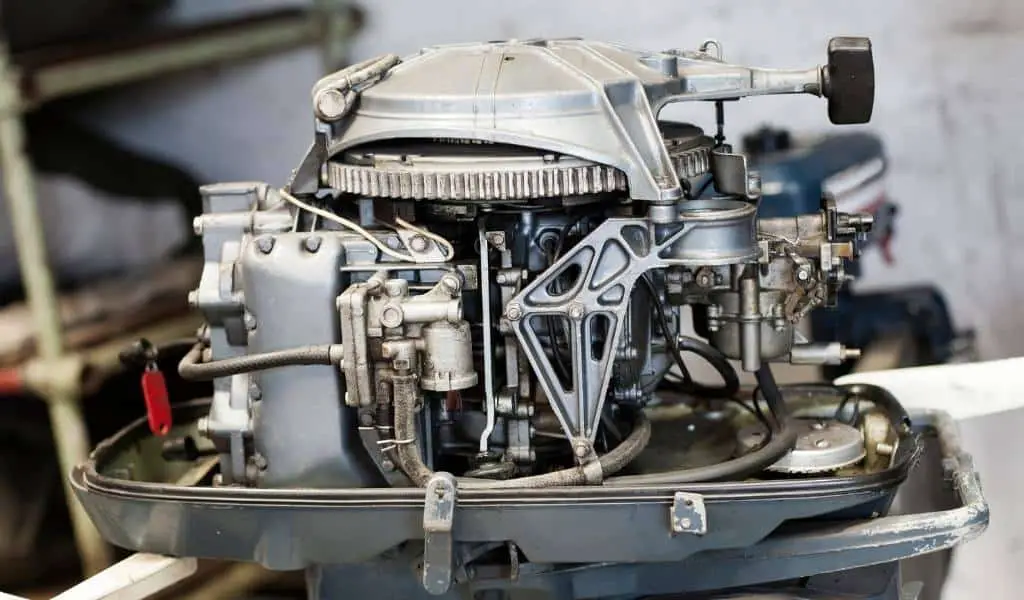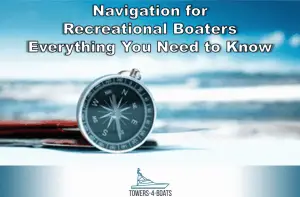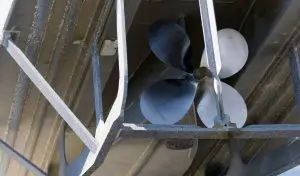Outboard motors are incredibly reliable. They are pretty simple engines, and few things can go wrong for well-cared-for motors. But everyone has an occasional snafu that requires some troubleshooting.
Anytime you have a problem with an outboard, always check the owner’s manual for tips and tricks. Most motor manuals include a section on troubleshooting common problems, and you’re likely to find most of your answers there. If you need to dive in any deeper, it’s worth investing in the shop manual too.
Before we go any further, it should be noted that nearly all outboard motor problems stem from fuel issues. Keep this in mind as you troubleshoot your engine, especially before you go down any rabbit holes, wondering about the ignition system or other problems. Outboards can and do die for other reasons, but it’s nearly always something to do with the fuel.
Outboard Motor Won’t Start
Your eyes, ears, and nose are your best friends when it comes to diagnosing mechanical issues. The quicker you notice and pick up on changes, the better. Has your motor sounded different lately? Has it been harder to start for no apparent reason? Has the amount of water coming out of the tell-tale changed? Hopefully, if you notice a change, you can pin down the cause before you have to move onto the troubleshooting and repair phase.
Here are some of the most common causes of your outboard motor not starting:
1. Spark Plugs
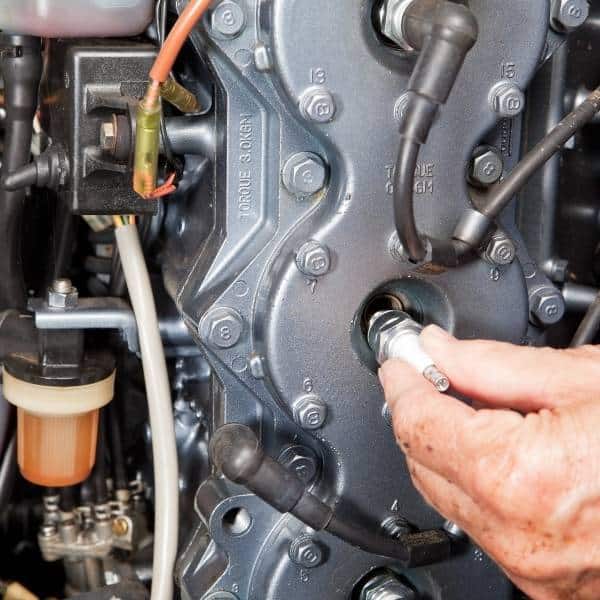
Being observant will also help you with the troubleshooting process when things go wrong. If your motor isn’t starting, what exactly is it doing? Engines need three things to run: air, spark, and fuel. Does it run, but then sputter and die? That would mean that the motor is getting air and spark because it did run for a second. Your troubleshooting would then immediately move to the fuel phase.
If it won’t start at all, this could be due to an issue with the spark plugs, these are often overlooked as everybody thinks the battery is the culprit. You should be regularly changing your spark plugs, if you haven’t done this for a while it’s almost certainly the problem.
Check the spark plug for damage. A functioning spark plug should be dry and grey, if it is black the engine has too much oil whereas a white color indicates it is getting too hot. If it’s not dry, this could point to water in the fuel. I’d recommend getting yourself a spark plug tester.
2. Dead battery
If your motor has an electric starter, troubleshooting the battery is not unlike a car. If you turn the key and only hear a clicking, it might be that the battery is dead. Look for obvious causes. Boats should be rigged with two batteries, one isolated from everything else on board, so that it retains its charge to start the motor. Sometimes the switch gets set wrong, and both batteries get drained by lights and bilge pumps.
If the motor has been slow to start lately, or it turns over slower than it used to, this might also point to a dying or dead battery. Try using your other battery to start it, or get a jump from another vessel. If onshore, plug in your battery charger and give it a try.
If the motor cranks with the same power that it always does, but won’t start, it’s time to look elsewhere.
3. Kill Switch
This is going to sound silly, but have you checked the kill switch? How many times have you gone to start a boat and realized that you forget to put in the kill switch? It happens. If you just replaced a kill switch key, are you positive it’s the right size? Some cheap generics are made too thin and don’t engage the switch properly.
Many engines also have integrated protections that prevent them from starting in gear. Check to make sure that the shifter is not in forward or reverse.
4. Fuel Problems
If the engine turns over or cranks like it always has, then chances are you are looking at a fuel problem. Always start troubleshooting with the simplest items first. Check the fuel system step by step, from the tank to the motor. Is there fuel in the tank? Is the fuel line in okay shape? Do you have a fuel shut-off valve, and if so, is it open? Even a small air leak can lead to starting problems, especially if your motor is fuel injected. Squeeze the primer bulb and make sure fuel is flowing. Listen for unusually air sucking sounds as you squeeze. Check all fuel line connections and hose clamps. If you have a fuel water separator with a sight bowl, check for contamination.
- Flooded Engine
It’s also worth noting that the engine might be flooded. A flooded engine has too much gas in the system, and not enough of it is atomizing to combust. It usually results from repeated starting attempts with the choke or primer out. The cure to getting a flooded motor to start is to close the choke and open the throttle to half or more while starting the engine. Give it a few tries, and if it doesn’t start, then wait ten minutes or so and try again. Some motors are very susceptible to flooding, while it happens to others very rarely.
If you’ve inspected everything and are confident that the engine isn’t flooded, the sure-fire way to narrow down your troubleshooting is to get a can of starting fluid. Take the cowling off of the motor and spray a short blast of fluid into the air intake. You want it to go more or less straight into the manifold. Try to start the engine again. If it starts briefly and runs off of the starting fluid, then you know with certainty that the problem is with your fuel system.
- Fuel Lines and Filters
At this point, it’s time to start double and triple-checking the fuel lines, primer bulb, and filters. Hopefully, you have spare fuel filters onboard, so changing them shouldn’t be a big deal. See if you notice any contamination or water in the fuel when you drain them, as that might be an important clue. If you have a separate portable fuel tank, try connecting that and see if the motor will run. Use fresh gasoline if you can.
5. Carburetor
If none of this has gotten your motor to start, it’s time to consider a problem with the engine. Since you know that it’s a fuel problem, the carburetor is the number one culprit. The narrow nozzles and passages of carburetors get clogged with containments, especially if you’ve gotten bad gasoline or let it sit for a long time. Ethanol fuels make these problems worse.
On small portable outboards, taking the carb off and cleaning it out isn’t that big a job. If your motor has more than one carburetor, it’s probably worth bringing in an expert. A quick look at the motor’s shop manual and parts diagrams will pay dividends before you dive into the task at hand. If the process looks like more than you’d like to take on, find a mechanic or a friend who has done the job before to walk you through it.
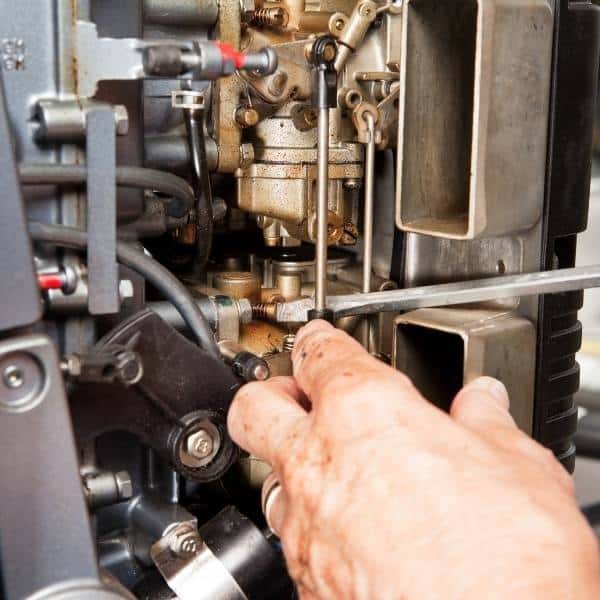
The general steps for cleaning a carburetor include removing the plastic air intake, fuel line, and throttle linkage. Cap the fuel line somehow, and then drain the float bowl at the bottom of the carb. The carburetor is held on by a few long bolts that are easy to remove, so the entire assembly should come off. Take care not to damage the gasket between the carb and the manifold, especially if you don’t have a spare one handy.
Move to a clean workbench or somewhere that you can’t lose tiny parts. The float bowl is held on by one screw, and then you should be able to remove the float and needle. You should now be able to access the main jet, which is the nozzle that sucks fuel out of the float bowl and sprays it into the venturi throat.
Put the small parts, especially the tiny jets, in a small jar of carb cleaner to soak. The longer you let it soak, the better. Overnight is preferable. Spray the rest of the carb with cleaner, paying particular attention to the tiny passages around the venturi throat and butterfly valve. Keep everything clean and dust-free.
The next morning, carefully reassemble the carb and reinstall it. Take care not to change the idle and mixture adjustment screws. Hopefully, your outboard purrs to life. If your efforts improved the situation and the motor, even if it’s not perfect, consider it a small victory. Consider buying a new set of jets for your carburetor or even an entire spare carb.
Look Online For Specific Advice
There are many web resources for home mechanics and DIYers. Sorting through it all is just a matter of using good keyword searches. Youtube, blogs, and online forums are full of people wondering the same things as you.
When you do internet searches for advice, it’s often helpful to include your exact make and model of outboard in the search query. Specific outboards tend to have similar problems. There are a lot of engines out there, and someone has likely had the same problem as you.
Still, weigh advice you get online with a heavy dose of skepticism. You can find data points, and it might provide some useful ideas for your troubleshooting. But what was right for one person may not be the solution for you. And of course, few people claiming to be experts actually are.
Conclusion
Every boater comes across an equipment problem from time to time. Boaters have to be somewhat independent problem solvers, especially if they’re away from the internet and towboat coverage. But by just maintaining your outboard carefully and being observant of changes in its behavior, you can head off nearly all problems.

